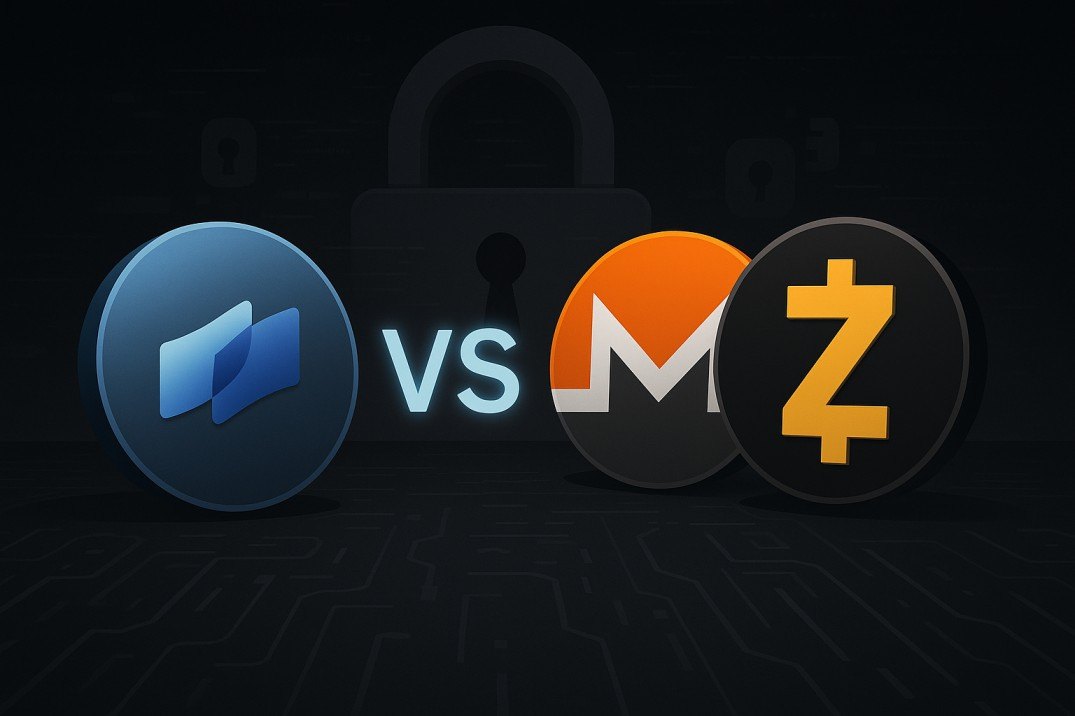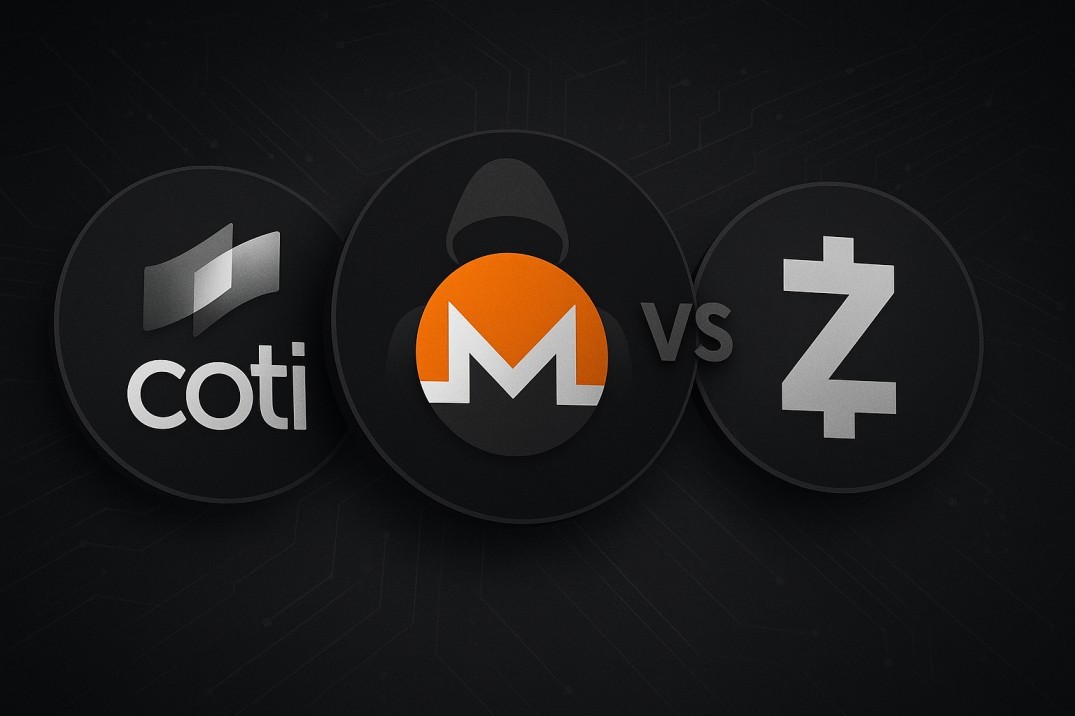TL;DR
- Monero provides always-on privacy using ring signatures, stealth addresses, and RingCT, making it strongly private but also a frequent target of regulatory scrutiny.
- Zcash supports optional privacy via zk-SNARKs, but many coins are held in transparent pools and usage patterns weaken anonymity.
- Exchanges have delisted many privacy coins (Monero, Zcash) under regulatory pressure, limiting liquidity and adoption.
- COTI introduces garbled circuits and a selective disclosure architecture built into its Layer 2, aiming to balance confidentiality, auditability, and compliance.
- COTI's privacy is modular and developer-centric, it may offer a more sustainable path for privacy in Web3 than purely anonymous coins.
Privacy has always been the quiet heartbeat of crypto. From Bitcoin's earliest days, the promise wasn't just digital money - it was financial freedom without surveillance. But as the industry matured and regulation tightened, privacy became the most contested pillar of Web3. For some, it's about personal sovereignty; for others, it's a regulatory red flag. In a world where every on-chain action is visible, people are demanding tools that let them decide what to share and when. Whether it's shielding wallet balances, securing business transactions, or protecting user data, privacy isn't just a feature - it's a necessity for a truly decentralized economy.
Yet, building privacy on transparent blockchains isn't easy. It's a constant tug-of-war between confidentiality and compliance, between user rights and regulatory oversight. Some projects, like Monero, go all-in on anonymity. Others, like Zcash, try to balance transparency and secrecy. And now, a new contender, COTI, is rethinking the entire model by introducing programmable, auditable privacy through cryptographic innovation.
In this article, we'll break down the three key players shaping the future of blockchain privacy - Monero, Zcash, and COTI - exploring how each one tackles the privacy puzzle, what tradeoffs they face, and why the next evolution of privacy might not come from coins, but from infrastructure itself.
Understanding the Players: Monero, Zcash, and COTI

Monero: Privacy by Default, Visibility by Target
Monero is often seen as the gold standard of privacy coins. Every transaction is private - sender, recipient, and amount are all obfuscated. It accomplishes this using ring signatures (which mix a transaction among decoy inputs), stealth addresses (creating a new address for every transaction), and Ring Confidential Transactions (RingCT) (which hide amounts). Together, these features deliver strong fungibility: every coin is indistinguishable.
However, that strength is also its vulnerability. Because Monero's privacy is always-on and opaque, it attracts disproportionate regulatory attention. As early as 2020, U.S. regulators labeled "anonymity-enhanced cryptocurrency" protocols as challenging to investigate, specifically naming Monero. Over time, Monero's adoption has also faced friction. Some exchanges have removed listing support in regulated jurisdictions, and concerns about network control (e.g. mining pool concentration) and chain reorgs have emerged.
Zcash: Optional Privacy & Real-World Tradeoffs
Zcash takes a different route. It allows both transparent and shielded (private) transactions via zk-SNARKs - cryptographic proofs that validate correctness without revealing sender, receiver, or amounts. However, in practice, much of ZEC remains in transparent pools, and the anonymity set is limited by usage behaviors and heuristics.
In fact, academic studies have shown that anonymity guarantees can degrade: users moving funds into and out of shielded pools, timing patterns, and usage heuristics all erode privacy. Zcash also faces regulatory and listing pressure. Many exchanges have flagged or delisted privacy features, especially in jurisdictions that demand traceability of funds.
COTI: Privacy as Infrastructure
COTI is not a "privacy coin" in the same mold as Monero or Zcash. Instead, it positions itself as a privacy-enabled layer - combining confidentiality, auditability, and developer flexibility. The core innovation is the use of garbled circuits, a cryptographic protocol enabling computation on encrypted data without revealing inputs or intermediate states. This allows private logic (contract execution, data handling) while maintaining the ability for authorized verification.
COTI's architecture is intentionally modular: developers can choose which parts of their app are private and which are transparent. This selective disclosure model helps reconcile privacy and compliance. Also, COTI claims performance advantages: lower latency, lighter computational load, and scalability relative to traditional privacy methods.
Comparative Strengths & Weaknesses

Privacy Strength
Monero: Very strong privacy by default - no transparency toggle. But because it's always private, it sometimes collides with regulatory constraints.
Zcash: Privacy is opt-in; shielded transactions can be strong, but much of the network remains transparent. Heuristics and patterns reduce anonymity.
COTI: Privacy is programmable and selective - confidential logic and data processing are possible, but parts can be revealed when needed for audits, compliance, or interoperability.
Auditability & Compliance
Monero: Auditing is extremely hard; regulators and institutions often shy away due to opaque flows.
Zcash: Some auditability is possible when users choose to use shielded or transparent addresses, but the mixed model complicates enforcement.
COTI: Because privacy is modular and controlled, COTI can embed verifiable disclosures - allowing audits, compliance, or selective revelation without bleeding all data.
Performance & Scalability
Privacy techniques typically introduce overhead (computation, memory, gas).
Monero has optimized privacy, but its privacy features are baked into its protocol - scaling limitations exist.
Zcash's zk-SNARKs also come with computational cost; many shielded operations are more resource-intensive.
COTI claims that its garbled circuits implementation is far more efficient: lower latency, less resource consumption, and better scaling for complex logic.
Ecosystem & Adoption Risk
Monero & Zcash: Because of regulatory scrutiny, many exchanges have delisted or attenuated support. In 2023-2024, OKX announced delisting of privacy coins including XMR and ZEC.
COTI: Because it isn't a pure anonymous coin, and because of its selective privacy model, it may be less exposed to delisting risk. Its architecture is more aligned with regulated institutions and compliance.
Regulatory & Market Pressure
Privacy coins live in a delicate balance between freedom and regulation. Many jurisdictions view them with suspicion, fearing misuse for money laundering, tax evasion, or illicit finance. Exchanges often preemptively delist or restrict privacy tokens to reduce compliance risk.
In late 2023, OKX announced plans to delist Monero and Zcash. Binance has sometimes flagged privacy coins by placing monitoring tags or risking delisting in particular jurisdictions. Monero in particular has been delisted in multiple regions. These pressures reduce liquidity, user access, and institutional trust in pure anonymity coins. Meanwhile, blockchains or layers with built-in privacy but compliance-friendly disclosure options may have a stronger shot at long-term survival.
Why COTI's Privacy Approach May Win Long-Term
1. Modular Privacy + Compliance
COTI offers a middle ground: privacy where needed, transparency where required. This balance makes it more palatable to institutions, regulators, and enterprise use cases.
2. Developer-Centric Confidential Logic
By enabling private computation (not just private transfers), COTI empowers applications like confidential DeFi, privacy-aware identity, private auctions, private contract logic.
3. Better Performance Tradeoffs
Garbage circuits (as implemented by COTI) aim for much lower overhead, making advanced privacy usable rather than academic.
4. Resilience to Delisting Pressure
Because COTI's privacy is boundary-controlled and audit-friendly, it's less likely to be targeted wholesale by exchanges seeking to satisfy regulators.
5. Evolving Privacy Norms
As mainstream blockchains (e.g. Ethereum) move toward native privacy upgrades, a privacy layer like COTI could become a core building block - rather than an isolated niche.
Risks, Tradeoffs & Considerations
No approach is perfect. Some challenges COTI must navigate:
- Circuit complexity & verification overhead: more advanced privacy logic may grow heavy; optimization is essential.
- Security assumptions & malicious adversaries: garbled circuits in adversarial settings require strong safeguards.
- Adoption friction: developers familiar with other privacy stacks may resist change.
- Interoperability leaks: when interacting with public contracts or chains, care is needed to avoid unintended data leakage.
- Regulatory shifts: even modular privacy may face new rules that limit or audit disclosure functionality.
Final Thoughts
The debate between COTI vs Monero vs Zcash is not just about which coin is more private - it's about what model of privacy is sustainable, scalable, and compatible with real-world constraints. Monero delivers robust anonymity, but at the cost of institutional friction and regulatory exposure. Zcash offers conditional privacy but suffers from real-world usage patterns that erode anonymity. COTI charts a different path: privacy as a programmable infrastructure, respecting both confidentiality and the realities of regulation and adoption.
In the long run, the architecture that survives is not the one that hides everything, but the one that hides what needs hiding - selectively, efficiently, and auditable when needed. COTI's privacy paradigm may not draw the most dramatic headlines today - but it might just outlast those that do.











